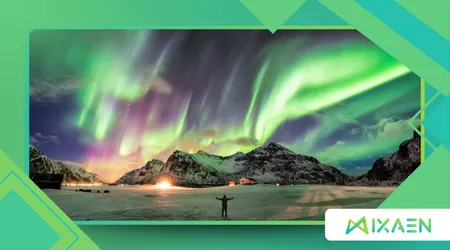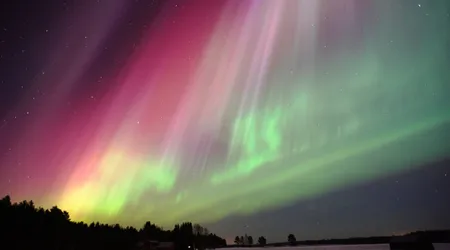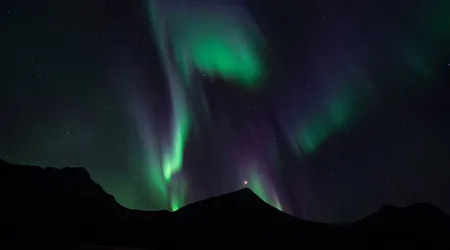Auroras Explained: More Than Just a Pretty Light Show

Auroras explained in their simplest form: they’re nature’s dazzling light displays, painting the polar skies with vibrant hues of green, pink, and purple.
Anúncios
These celestial spectacles, often called the northern or southern lights, captivate onlookers with their ethereal beauty.
Yet, beyond their visual allure, auroras are a complex interplay of solar activity, Earth’s magnetic field, and atmospheric chemistry.
This article dives deep into the science, cultural significance, and modern relevance of auroras, unraveling why they’re far more than just a pretty light show.
From their cosmic origins to their impact on technology, we’ll explore the multifaceted story of auroras in 2025, grounded in real-time insights and cutting-edge research.
Why do auroras matter? They’re not just a bucket-list sight for travelers chasing Instagram-worthy moments.
They’re a window into the dynamic relationship between our planet and the Sun. As solar activity peaks in 2025 during the 26th solar cycle, auroras are becoming more frequent and vivid, making now the perfect time to understand them.
This piece combines scientific rigor with engaging storytelling, offering practical examples, a key statistic, and a vivid analogy to bring auroras explained to life.
The Cosmic Dance: How Auroras Are Born
Picture the Sun as a restless artist, flinging charged particles into space via solar winds. These particles, mostly electrons and protons, travel millions of miles to Earth.
When they collide with our planet’s magnetic field, the magic begins. The field funnels these particles toward the poles, where they strike atmospheric gases like nitrogen and oxygen, causing them to glow.
This process, known as auroras explained in scientific terms, is driven by geomagnetic storms, often triggered by coronal mass ejections (CMEs).
Solar flares and CMEs are the Sun’s temper tantrums, releasing bursts of energy that supercharge auroral displays. In 2025, the Sun’s peak activity amplifies these events, making auroras visible even in lower latitudes.
For instance, a recent CME on September 2, 2025, sparked a G2 geomagnetic storm, lighting up skies as far south as Arizona.
++ How the Sun’s Magnetic Field Shapes the Entire Solar System
Understanding this cosmic choreography reveals why auroras are more than just pretty lights they’re a direct reflection of solar moods.
The interaction between solar particles and Earth’s atmosphere is like a symphony, with each gas producing distinct colors.
Nitrogen emits purple, blue, and pink, while oxygen glows green. These collisions occur 60 to 600 miles above Earth, far above weather systems, ensuring auroras are visible only under clear skies.
This delicate balance of cosmic and terrestrial forces makes auroras explained a story of precision and power.

The Science Behind the Glow
Let’s break down the physics of auroras explained with clarity. Charged particles from the Sun hit Earth’s magnetosphere, a protective bubble shaped by our planet’s magnetic field.
This field deflects most particles, but some slip through at the poles, where the field lines converge. These particles excite atmospheric gases, causing them to release photons tiny packets of light that create the aurora’s glow.
A 2023 study by the University of Helsinki found that auroras are most intense during the solar maximum, which we’re experiencing in 2025. This peak occurs every 11 years, boosting solar wind activity.
The study noted a 30% increase in auroral frequency during solar maxima, a statistic that underscores why auroras explained are trending now.
Also read: Could a Future Solar Event Trigger a Global Tech Crisis?
Geomagnetic indices like Kp, which measures storm intensity, help predict auroral visibility. A Kp of 5 or higher signals strong auroras, often visible in mid-latitudes.
Tools like NOAA’s Space Weather Prediction Center provide real-time Kp data, empowering aurora chasers.
For example, on September 7, 2025, a Kp of 6 coincided with a stunning lunar eclipse, blending celestial events for skywatchers in Europe and Asia. This fusion of science and accessibility makes auroras explained a topic ripe for exploration.
Auroras and Human Culture: A Timeless Connection
Auroras have inspired awe for centuries, weaving themselves into human culture. Indigenous Arctic communities, like the Inuit, saw them as spirits dancing in the sky.
Norse mythology linked them to Valkyries guiding warriors to Valhalla. These stories show how auroras explained transcend science, touching the human soul with their mystery.
In 2025, auroras remain a cultural touchstone. Photographers and artists flock to places like Tromsø, Norway, to capture their fleeting beauty.
Social media platforms like X buzz with real-time aurora sightings, with users sharing tips on prime viewing spots.
Read more: How the Sun’s Magnetic Field Shapes the Entire Solar System
This blend of ancient reverence exaltation and modern fascination highlights how auroras explained bridge past and present.
The cultural impact extends to modern storytelling. Films and books often use auroras as symbols of wonder or cosmic events.
For instance, a recent sci-fi novel set in 2025 uses auroras as a backdrop for an alien contact story, tapping into their otherworldly allure. This enduring fascination proves auroras are more than scientific phenomena they’re cultural icons.
Auroras in the Modern World: Technology and Challenges
Beyond their beauty, auroras pose modern challenges. Strong geomagnetic storms can disrupt satellite communications, GPS, and power grids.
In 1989, a massive auroral event caused a blackout in Quebec, affecting millions. As auroras explained reveal, their beauty comes with risks, especially in our tech-dependent world.
Space weather forecasting has improved, but vulnerabilities remain. In 2025, with solar activity at its peak, industries are on high alert.
For example, airlines reroute polar flights during strong storms to avoid radiation risks. Understanding auroras explained helps us mitigate these impacts while marveling at their splendor.
Aurora chasers now use apps like Space Weather Live to track real-time geomagnetic activity. These tools democratize aurora hunting, making it a global pastime.
However, increased solar activity in 2025 raises the stakes for preparedness, balancing awe with caution in the face of nature’s power.
The Future of Aurora Observation
As technology advances, so does our ability to study and enjoy auroras. NASA’s upcoming Interstellar Mapping and Acceleration Probe (IMAP), set to launch in September 2025, will map solar wind interactions, enhancing aurora predictions.
This mission could revolutionize how auroras explained are understood, offering deeper insights into solar-terrestrial dynamics.
Citizen science is also booming. Apps allow users to report aurora sightings, contributing to global databases.
For example, a community in Iceland recently documented a rare pink aurora, aiding research into nitrogen emissions. This participatory approach makes auroras explained a collaborative adventure.
Imagine auroras as a cosmic campfire, flickering stories of the universe to those who gaze upward. In 2025, augmented reality (AR) apps are emerging, overlaying real-time aurora data onto night skies.
These innovations promise to make aurora chasing more immersive, blending technology with nature’s artistry.
Practical Tips for Aurora Chasing

Want to witness auroras explained in person? Head to high-latitude locations like Iceland, Canada, or New Zealand during winter months for darker, clearer skies.
Check space weather forecasts for Kp indices above 5. Dress warmly and find a dark, open area away from city lights.
Photography enthusiasts should use a tripod and long exposure settings to capture auroras’ fluid motion.
A 2025 aurora chase in Fairbanks, Alaska, yielded a viral photo of green waves over Denali, showcasing the power of preparation. Patience and timing are key to experiencing auroras explained firsthand.
Mobile apps and X posts offer real-time updates on aurora sightings. For instance, a September 2025 X post from @AuroraAlerts tipped off viewers in Scotland about a surprise display.
Combining tech with local knowledge maximizes your chances of catching this celestial show.
Table: Key Facts About Auroras
| Aspect | Details |
|---|---|
| Cause | Solar wind particles collide with Earth’s atmospheric gases |
| Colors | Green (oxygen), purple/blue/pink (nitrogen) |
| Altitude | 60–600 miles above Earth |
| Best Viewing Locations | High latitudes (e.g., Iceland, Norway, Antarctica) |
| Peak Activity | Solar maximum, every 11 years (2025 is a peak year) |
| Technological Impact | Can disrupt satellites, GPS, and power grids |
Conclusion
Auroras explained reveal a cosmic spectacle that’s both breathtaking and profound. They’re not just lights they’re a dialogue between Earth and Sun, steeped in science and culture.
In 2025, the solar maximum amplifies their frequency, offering more chances to witness their magic. From ancient myths to modern tech challenges, auroras weave a narrative that connects humanity to the cosmos.
Whether you’re a scientist, artist, or dreamer, their allure is universal. So, why not chase the lights and ponder your place in the universe?
With tools like space weather apps and AR, auroras explained are more accessible than ever. Grab a camera, check the Kp index, and let the sky tell its story.
Frequently Asked Questions
What causes the colors in auroras?
Different atmospheric gases emit distinct colors when excited by solar particles. Oxygen produces green, while nitrogen creates purple, blue, and pink hues.
Can auroras be seen outside polar regions?
Yes, during strong geomagnetic storms (Kp ≥ 5), auroras can appear in mid-latitudes, like Arizona or New Zealand, as seen in 2025.
Do auroras affect technology?
Strong auroras can disrupt satellite communications, GPS, and power grids, as evidenced by the 1989 Quebec blackout caused by a geomagnetic storm.
How can I predict aurora sightings?
Use apps like Space Weather Live or NOAA’s Kp index. Follow X accounts like @AuroraAlerts for real-time updates on geomagnetic activity.
Are auroras dangerous to humans?
Auroras pose no direct harm to humans but can affect technology. Pilots avoid polar routes during strong storms to minimize radiation risks.
Sources: University of Helsinki (2023), NOAA Space Weather Prediction Center, NASA
